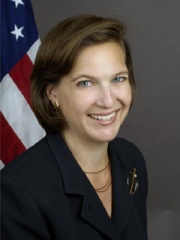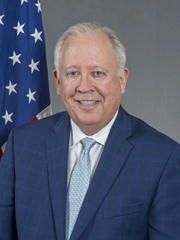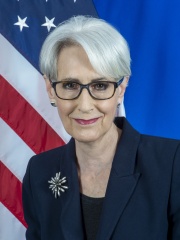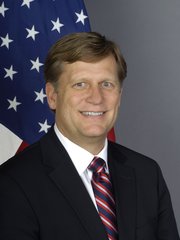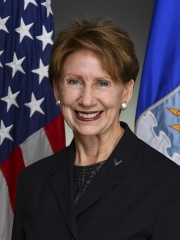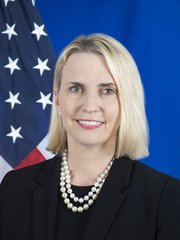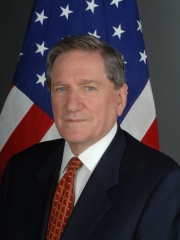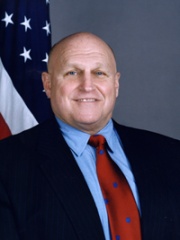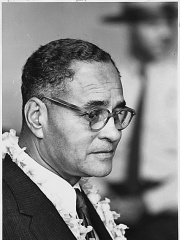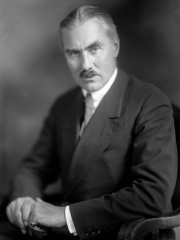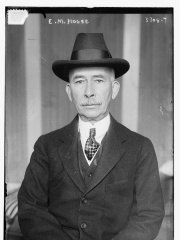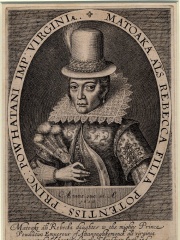
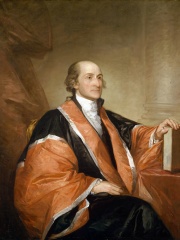
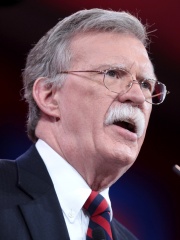
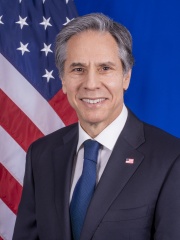
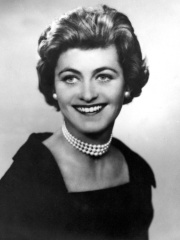
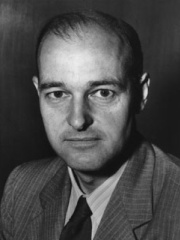
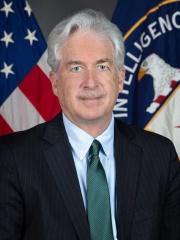
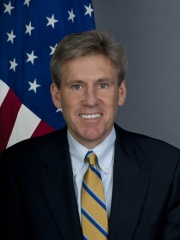
The Most Famous
DIPLOMATS from United States
This page contains a list of the greatest American Diplomats. The pantheon dataset contains 90 Diplomats, 23 of which were born in United States. This makes United States the birth place of the most number of Diplomats.
Top 10
The following people are considered by Pantheon to be the top 10 most legendary American Diplomats of all time. This list of famous American Diplomats is sorted by HPI (Historical Popularity Index), a metric that aggregates information on a biography's online popularity. Visit the rankings page to view the entire list of American Diplomats.

1. Pocahontas (1595 - 1617)
With an HPI of 85.50, Pocahontas is the most famous American Diplomat. Her biography has been translated into 61 different languages on wikipedia.
Pocahontas (US: , UK: ; born Amonute, also known as Matoaka and Rebecca Rolfe; c. 1596 – March 1617) was a Native American woman belonging to the Powhatan people, notable for her association with the colonial settlement at Jamestown, Virginia. She was the daughter of Wahunsenacawh, the paramount chief of a network of tributary tribes in the Tsenacommacah (known in English as the Powhatan Confederacy), encompassing the Tidewater region of what is today the U.S. state of Virginia. Pocahontas was captured and held for ransom by English colonists during hostilities in 1613. During her captivity, she was encouraged to convert to Christianity and was baptized under the name Rebecca. She married the tobacco planter John Rolfe in April 1614 at the age of about 17 or 18, and she bore their son, Thomas Rolfe, in January 1615. In 1616, the Rolfes travelled to London, where Pocahontas was presented to English society as an example of the "civilized savage" in hopes of stimulating investment in Jamestown. On this trip, she may have met Squanto, a Patuxet man from New England. Pocahontas became a celebrity, was elegantly fêted, and attended a masque at Whitehall Palace. In 1617, the Rolfes intended to sail for Virginia, but Pocahontas died at Gravesend, Kent, England, of unknown causes, aged 20 or 21. She was buried in St George's Church, Gravesend; her grave's exact location is unknown because the church was rebuilt after being destroyed by a fire. Numerous places, landmarks, and products in the United States have been named after Pocahontas. Her story has been romanticized over the years, many aspects of which are fictional. Many of the stories told about her by the English explorer John Smith have been contested by her documented descendants. She is a subject of art, literature, and film. Many famous people have claimed to be among her descendants, including members of the First Families of Virginia, First Lady Edith Wilson, American actor Glenn Strange, and astronomer Percival Lowell.

2. John Jay (1745 - 1829)
With an HPI of 78.08, John Jay is the 2nd most famous American Diplomat. His biography has been translated into 48 different languages.
John Jay (December 23 [O.S. December 12], 1745 – May 17, 1829) was an American statesman, diplomat, signatory of the Treaty of Paris, and a Founding Father of the United States. He served from 1789 to 1795 as the first chief justice of the United States and from 1795 to 1801 as the second governor of New York. Jay directed U.S. foreign policy for much of the 1780s and was an important leader of the Federalist Party after the ratification of the United States Constitution in 1788. Jay was born into a wealthy family of merchants and New York City government officials of French Huguenot and Dutch descent. He became a lawyer and joined the New York Committee of Correspondence, organizing American opposition to British policies such as the Intolerable Acts in the leadup to the American Revolution. Jay was elected to the First Continental Congress, where he signed the Continental Association, and to the Second Continental Congress, where he served as its president. From 1779 to 1782, Jay served as the ambassador to Spain; he persuaded Spain to provide financial aid to the fledgling United States. He also served as a negotiator of the Treaty of Paris, in which Britain recognized American independence. Following the end of the war, Jay served as Secretary of Foreign Affairs, directing United States foreign policy under the Articles of Confederation government. He also served as the first secretary of state on an interim basis. A proponent of strong, centralized government, Jay worked to ratify the United States Constitution in New York in 1788. He was a co-author of The Federalist Papers along with Alexander Hamilton and James Madison, and wrote five of the eighty-five essays. After the establishment of the new federal government, Jay was appointed by President George Washington the first Chief Justice of the United States, serving from 1789 to 1795. The Jay Court experienced a light workload, deciding just four cases over six years. In 1794, while serving as chief justice, Jay negotiated the highly controversial Jay Treaty with Britain. Jay received a handful of electoral votes in three of the first four presidential elections but never undertook a serious bid for the presidency. Jay served as the governor of New York from 1795 to 1801. Although he successfully passed gradual emancipation legislation as governor of the state, he owned five slaves as late as 1800. In the waning days of President John Adams' administration, Jay was confirmed by the Senate for another term as chief justice, but he declined the position and retired to his farm in Westchester County, New York.

3. John R. Bolton (b. 1948)
With an HPI of 75.90, John R. Bolton is the 3rd most famous American Diplomat. His biography has been translated into 43 different languages.
John Robert Bolton II (born November 20, 1948) is an American attorney, diplomat, Republican consultant, and political commentator who served as the 25th United States ambassador to the United Nations from 2005 to 2006, and as the 26th United States national security advisor from 2018 to 2019. Bolton served as a United States assistant attorney general for President Ronald Reagan from 1985 to 1989. He served in the State Department as the assistant secretary of state for international organization affairs from 1989 to 1993, and the under secretary of state for arms control and international security affairs from 2001 to 2005. He was an advocate of the Iraq War as a Director of the Project for the New American Century, which favored going to war with Iraq. He was the U.S. Ambassador to the United Nations from August 2005 to December 2006, as a recess appointee by President George W. Bush. He stepped down at the end of his recess appointment in December 2006 because he was unlikely to win confirmation in the Senate, of which the Democratic Party had control at the time. Bolton later served as National Security Advisor to President Donald Trump from April 2018 to September 2019. He repeatedly called for the termination of the Iran nuclear deal, from which the U.S. withdrew in May 2018. He wrote a best-selling book about his tenure in the Trump administration, The Room Where It Happened, published in 2020. Bolton is widely considered a foreign policy hawk and advocates military action and regime change by the U.S. in Iran, Syria, Libya, Venezuela, Cuba, Yemen, and North Korea. A member of the Republican Party, his political views have been described as American nationalist, conservative, and neoconservative, although Bolton rejects the last term. He is a former senior fellow at the American Enterprise Institute (AEI) and a Fox News Channel commentator. He was a foreign policy adviser to 2012 Republican presidential nominee Mitt Romney. In October 2025, Bolton was indicted on eight counts of unlawful transmission and ten counts of unlawful retention of national defense information between 2018 and 2025.

4. Antony Blinken (b. 1962)
With an HPI of 74.73, Antony Blinken is the 4th most famous American Diplomat. His biography has been translated into 68 different languages.
Antony John Blinken (born April 16, 1962) is an American lawyer and diplomat who served as the 71st United States secretary of state from 2021 to 2025. He previously served as deputy national security advisor from 2013 to 2015 and deputy secretary of state from 2015 to 2017 under President Barack Obama. Blinken was previously national security advisor to then-vice president Joe Biden from 2009 to 2013. During the Clinton administration, Blinken served in the State Department and in senior positions on the National Security Council from 1994 to 2001. He was a senior fellow at the Center for Strategic and International Studies from 2001 to 2002. He advocated for the 2003 invasion of Iraq while serving as the Democratic staff director of the Senate Foreign Relations Committee from 2002 to 2008. He was a foreign policy advisor for Joe Biden's 2008 presidential campaign, before advising the Obama–Biden presidential transition. From 2009 to 2013, Blinken served as deputy assistant to the president and national security advisor to the vice president. During his tenure in the Obama administration, he helped craft U.S. policy on Afghanistan, Pakistan, and the nuclear program of Iran. After leaving government service, Blinken moved into the private sector, co-founding WestExec Advisors, a consulting firm. Blinken returned to government first as a foreign policy advisor for Biden's 2020 presidential campaign, then as Biden's pick for secretary of state, a position the Senate confirmed him for on January 26, 2021.
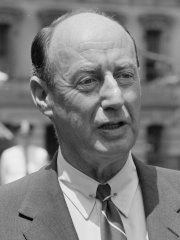
5. Adlai Stevenson II (1900 - 1965)
With an HPI of 74.51, Adlai Stevenson II is the 5th most famous American Diplomat. His biography has been translated into 36 different languages.
Adlai Ewing Stevenson II (; February 5, 1900 – July 14, 1965) was an American politician and diplomat who was the United States ambassador to the United Nations from 1961 until his death in 1965. He previously served as the 31st governor of Illinois from 1949 to 1953 and was the Democratic Party nominee for president of the United States in 1952 and 1956, losing both elections to Dwight D. Eisenhower. Stevenson was the grandson of Adlai Stevenson, the 23rd vice president of the United States. He was raised in Bloomington, Illinois. After a short stint in the U.S. Navy at the end of World War I, he became a lawyer. He served in many positions in the federal government during the Franklin D. Roosevelt and Harry Truman presidential administrations, including in the Department of the Navy, and the State Department during World War II. In 1945, he served on the committee that created the United Nations, and was a member of the initial U.S. delegations to the UN. In 1948, Stevenson was elected governor of Illinois, defeating incumbent governor Dwight H. Green in an upset. As governor, Stevenson reformed the state police, cracked down on illegal gambling, improved the state highways, and attempted to cleanse the state government of corruption. Stevenson also sought, with mixed success, to reform the Illinois state constitution and introduced several crime bills in the state legislature. In 1952 and 1956, Stevenson was chosen as the Democratic nominee for president but was defeated in a landslide by Eisenhower both times, campaigning on themes of diplomatic engagement, moderate economic management, and the preservation of civil liberties amid the tensions of the early Cold War. In 1960, he unsuccessfully sought the Democratic presidential nomination for a third time at the Democratic National Convention. After President John F. Kennedy was elected, persistent tensions – particularly Kennedy's perception that Stevenson had been late to endorse his candidacy – prompted Kennedy to decline offering him a cabinet position and instead appoint him as the United States ambassador to the United Nations (UN). Two major events Stevenson dealt with during his time as UN ambassador were the Bay of Pigs Invasion of Cuba in April 1961 and the Cuban Missile Crisis in October 1962. He was still serving as UN ambassador through the Lyndon Johnson administration when he suffered a heart attack during a visit to London on July 14, 1965, dying later that day at the age of 65. He is buried in Evergreen Cemetery in his hometown of Bloomington, Illinois.

6. Jean Kennedy Smith (1928 - 2020)
With an HPI of 71.31, Jean Kennedy Smith is the 6th most famous American Diplomat. Her biography has been translated into 28 different languages.
Jean Ann Kennedy Smith (née Kennedy; February 20, 1928 – June 17, 2020) was an American diplomat, activist, humanitarian, and author who served as United States Ambassador to Ireland from 1993 to 1998. A member of the Kennedy family, Kennedy was the eighth of nine children (and youngest daughter) born to Joseph P. Kennedy Sr. and Rose Kennedy. Her siblings included President of the United States John F. Kennedy, United States Senator Robert F. Kennedy of New York, United States Senator Ted Kennedy of Massachusetts, Rosemary Kennedy, and Special Olympics founder Eunice Kennedy Shriver. As Ambassador to Ireland, Smith was instrumental in the Northern Ireland peace process as President Bill Clinton's representative in Dublin. She successfully urged President Clinton to grant a controversial visa to Sinn Féin President Gerry Adams; Adams's ensuing trip to the United States helped lead to an Irish Republican Army ceasefire. Smith was later reprimanded by Secretary of State Warren Christopher for retaliating against two employees who disagreed with her stance on the Adams visa. Smith stepped down from her ambassador position shortly after the signing of the historic Good Friday Agreement in 1998. President of Ireland Mary McAleese conferred honorary Irish citizenship on Smith in 1998 in recognition of her service to the country. Smith was the founder of VSA Kennedy Center (previously Very Special Arts), an internationally recognized non-profit organization dedicated to creating a society where people with disabilities can engage with the arts. In 2011, she was awarded the Presidential Medal of Freedom, the highest civilian honor in the United States, by President Barack Obama for her work with VSA and with people with disabilities.

7. George F. Kennan (1904 - 2005)
With an HPI of 68.97, George F. Kennan is the 7th most famous American Diplomat. His biography has been translated into 48 different languages.
George Frost Kennan (February 16, 1904 – March 17, 2005) was an American diplomat and historian. He was best known as an advocate of a policy of containment of Soviet expansion during the Cold War. He lectured widely and wrote scholarly histories of the relations between the USSR and the United States. He was also one of the group of foreign policy elders known as "The Wise Men". During the late 1940s, his writings confirmed the Truman Doctrine and inspired the U.S. foreign policy of containing the USSR. His "Long Telegram" from Moscow in 1946 and the subsequent 1947 article "The Sources of Soviet Conduct" argued that the Soviet regime was inherently expansionist and that its influence had to be "contained" in areas of vital strategic importance to the United States. These texts provided justification for the Truman administration's new anti-Soviet policy. Kennan played a major role in the development of definitive Cold War programs and institutions, notably the Marshall Plan. Soon after his concepts had become U.S. policy, Kennan began to criticize the foreign policies that he had helped articulate. By late 1948, Kennan became confident that the US could commence positive dialogue with the Soviet government. His proposals were dismissed by the Truman administration, and Kennan's influence waned, particularly after Dean Acheson was appointed Secretary of State in 1949. Soon thereafter, U.S. Cold War strategy assumed a more assertive and militaristic quality, causing Kennan to lament what he believed was an abrogation of his previous assessments. In 1950, Kennan left the State Department—except for a brief ambassadorial stint in Moscow and a longer one in Yugoslavia—and became a realist critic of U.S. foreign policy. He continued to analyze international affairs as a faculty member of the Institute for Advanced Study from 1956 until his death in 2005 at age 101.

8. William J. Burns (b. 1956)
With an HPI of 68.14, William J. Burns is the 8th most famous American Diplomat. His biography has been translated into 29 different languages.
William Joseph Burns (born April 11, 1956) is an American diplomat who served as the 8th director of the Central Intelligence Agency (CIA) during the Biden administration from March 19, 2021 to January 20, 2025. He previously served as U.S. deputy secretary of state from 2011 to 2014; in 2009 he served as acting secretary of state for a day, prior to the confirmation of Hillary Clinton. Burns retired from the U.S. Foreign Service in 2014 after a 32-year career. From 2014 to 2021, he served as president of the Carnegie Endowment for International Peace. Burns served as ambassador to Jordan from 1998 to 2001, Assistant Secretary of State for Near East Affairs from 2001 to 2005, ambassador to Russia from 2005 to 2008 and Under Secretary of State for Political Affairs from 2008 to 2011. In January 2021, President Joe Biden nominated Burns to become CIA director. He was unanimously confirmed by voice vote in the Senate on March 18, 2021, sworn in officially as director on March 19, as well as ceremonially sworn in by Vice President Kamala Harris on March 23. In July 2023, Biden elevated Burns to a position in his cabinet, a largely symbolic action.

9. J. Christopher Stevens (1960 - 2012)
With an HPI of 66.98, J. Christopher Stevens is the 9th most famous American Diplomat. His biography has been translated into 32 different languages.
John Christopher Stevens (April 18, 1960 – September 11, 2012) was an American career diplomat and lawyer who served as the U.S. Ambassador to Libya from May 22, 2012, to September 11, 2012. Stevens was killed when the U.S. Special Mission in Benghazi, Libya, was attacked by members of Ansar al-Sharia on September 11–12, 2012., making Stevens the eighth U.S. Ambassador to be killed while in office.
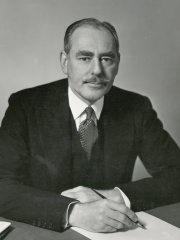
10. Dean Acheson (1893 - 1971)
With an HPI of 64.51, Dean Acheson is the 10th most famous American Diplomat. His biography has been translated into 42 different languages.
Dean Gooderham Acheson ( ATCH-iss-ən; April 11, 1893 – October 12, 1971) was an American politician and lawyer. As the 51st U.S. secretary of state, he set the foreign policy of the Harry S. Truman administration from 1949 to 1953. He was also Truman's main foreign policy advisor from 1945 to 1947 during early years of the Cold War. Acheson helped design the Truman Doctrine and the Marshall Plan, as well as the North Atlantic Treaty Organization. He was in private law practice from July 1947 to December 1948. After 1949, Acheson came under political attack from Republicans led by Senator Joseph McCarthy over Truman's policy toward the People's Republic of China. During the Cuban Missile Crisis of 1962, President John F. Kennedy called upon Acheson for advice, bringing him into the executive committee (ExComm), a strategic advisory group. As a private citizen in 1968, he counseled President Lyndon B. Johnson to negotiate for peace with North Vietnam.
People
Pantheon has 23 people classified as American diplomats born between 1595 and 1969. Of these 23, 9 (39.13%) of them are still alive today. The most famous living American diplomats include John R. Bolton, Antony Blinken, and William J. Burns. The most famous deceased American diplomats include Pocahontas, John Jay, and Adlai Stevenson II. As of April 2024, 2 new American diplomats have been added to Pantheon including Michael McFaul, and Bridget Brink.
Living American Diplomats
Go to all RankingsJohn R. Bolton
1948 - Present
HPI: 75.90
Antony Blinken
1962 - Present
HPI: 74.73
William J. Burns
1956 - Present
HPI: 68.14
Victoria Nuland
1961 - Present
HPI: 60.38
Thomas A. Shannon Jr.
1958 - Present
HPI: 53.37
Wendy Sherman
1949 - Present
HPI: 53.31
Michael McFaul
1963 - Present
HPI: 50.97
Barbara Barrett
1950 - Present
HPI: 47.70
Bridget Brink
1969 - Present
HPI: 38.87
Deceased American Diplomats
Go to all RankingsPocahontas
1595 - 1617
HPI: 85.50
John Jay
1745 - 1829
HPI: 78.08
Adlai Stevenson II
1900 - 1965
HPI: 74.51
Jean Kennedy Smith
1928 - 2020
HPI: 71.31
George F. Kennan
1904 - 2005
HPI: 68.97
J. Christopher Stevens
1960 - 2012
HPI: 66.98
Dean Acheson
1893 - 1971
HPI: 64.51
Richard Holbrooke
1941 - 2010
HPI: 63.24
Richard Armitage
1945 - 2025
HPI: 61.92
Ralph Bunche
1904 - 1971
HPI: 61.70
Joseph Grew
1880 - 1965
HPI: 57.77
Edward M. House
1858 - 1938
HPI: 56.53
Newly Added American Diplomats (2025)
Go to all RankingsOverlapping Lives
Which Diplomats were alive at the same time? This visualization shows the lifespans of the 13 most globally memorable Diplomats since 1700.

